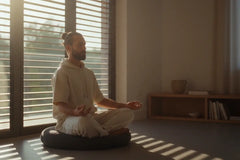13 Tips to Stop Falling Asleep During Meditation

Falling asleep during meditation frustrates many beginners. You sit down to find calm, but your eyes close, and your mind drifts.
Don’t worry, this happens to almost everyone. The good news? With the right techniques, timing, and small adjustments, you can stay alert, enjoy every session, and experience meditation’s full benefits without dozing off.
Key Takeaways
Meditate at Peak Alertness: Choose a time of day when your energy is naturally high, like early morning.
Sit Upright and Active: Maintain a straight, relaxed posture to stay alert and focused.
Energize Before Meditating: Do light stretches, a brisk walk, or gentle movement to wake up your body and mind.
Use Sensory Cues: Keep your eyes slightly open, use light, and background sounds to prevent drowsiness.
Keep It Manageable: Short, consistent sessions and switching techniques help maintain focus and engagement.
13 Tips to Stop Falling Asleep During Meditation
Meditate at the Right Time of Day
Choosing the right time of day for meditation can make a noticeable difference in focus and alertness.
Research highlighted in Advances in Psychiatry and Neurology shows that our circadian rhythms, our body’s internal 24-hour clock, create natural peaks and dips in energy, affecting both mental and physical performance.
Aligning meditation with these rhythms can help maintain alertness and reduce drowsiness. Traditionally, yogis have long valued meditating during Brahma muhūrta, the hour before sunrise, when the mind is quiet, energy is high, and mental clarity is optimal.
Supporting this, data from the Journal of Medical Internet Research found that morning meditation not only aligns with natural alertness patterns but also promotes higher engagement and consistency in maintaining the practice, whereas late-night meditation is more likely to lead to sleep.
By understanding your chronotype and scheduling sessions during peak alertness, you can maximize the benefits of meditation, stay focused, and avoid nodding off, creating a more fulfilling and sustainable practice.
Sit Upright to Stay Awake
One of the simplest ways to stay awake during meditation is to sit upright rather than slumping or lying down.
Research shows that posture plays a key role in alertness, when you keep your spine naturally straight, with shoulders relaxed and head aligned, you’re less likely to drift into drowsiness and more likely to maintain steady focus.
An upright posture also supports energy flow and balanced breathing, which traditions like yoga and Buddhism have long emphasized for staying awake.
Modern science backs this up too: Frontiers in Human Neuroscience found that cognitive performance, such as working memory, can differ between sitting upright and lying down, with sitting linked to sharper focus.
Similarly, a study in the Journal of Behavior Therapy and Experimental Psychiatry reported that adopting an upright posture not only reduced fatigue but also boosted positive mood.
Meditation teachers echo these findings, recommending a balanced, relaxed posture, whether on a cushion, in a chair, or even standing, to keep the body comfortable yet alert, preventing sleepiness while deepening awareness.

Do a Quick Physical Warm-Up
If you find yourself dozing off during meditation, a quick warm-up can help energize both your body and mind.
Light physical activity, even just one to three minutes of stretching or a brisk walk, boosts blood circulation and oxygen flow to the brain.
This not only wakes you up but also supports memory, learning, and sharper thinking by stimulating hormones that help brain cells grow.
Studies show that even short sessions of movement, like a 10-minute walk, can immediately reduce drowsiness and improve focus by increasing brain chemicals such as dopamine, serotonin, and norepinephrine.
These neurotransmitters regulate mood, attention, and alertness, making it easier to stay awake and centered during meditation.
In fact, exercise is so powerful that it can temporarily heighten attention and working memory for up to an hour, while regular activity protects brain health long term.
Think of a warm-up as a reset button, just a few mindful movements can spark energy, improve mood, and prepare you to meditate with clarity instead of fighting off sleep.
Keep Your Eyes Slightly Open
Keeping your eyes slightly open helps your brain stay alert. A soft downward gaze on a single point prevents eye strain. Relax your eyelids and focus for 10–30 minutes to stay present and alert during meditation.

Focus on Active Breathing
Active breathing means focusing on each inhale and exhale to stay alert. You can count breaths or notice the air moving through your nose.
Pay attention to both inhale and exhale, though following the exhale may be easier. Slow, controlled breaths work best, but slightly faster breathing can also energize you. This practice strengthens awareness and keeps you alert during meditation.
Try Guided Meditation
Guided meditation involves following a leader who provides instructions and techniques to stay alert.
Short sessions help prevent sleepiness, while longer ones suit those with more focus. Many guided meditations emphasize breathing or body awareness to keep the mind awake.
Apps like Calm, Headspace, and Insight Timer offer numerous options. Choosing the right guide and style can make meditation engaging and energizing.
Use Light or Background Noise
If you find yourself nodding off during meditation, light and sound can be powerful tools to help you stay awake.
Research published in the Journal of Research in Health Sciences highlights that exposure to bright light, especially short wavelength light like morning daylight, suppresses melatonin, boosts alertness, sharpens attention, and speeds up reaction time.
On the flip side, dim or dark settings encourage melatonin release, making you more likely to drift off.
That’s why practicing in a well-lit room or near natural sunlight can keep you alert while still relaxed.
Similarly, sound plays a surprising role in focus. Studies show that background noise, such as white noise or gentle nature sounds, creates a stable auditory environment that prevents distractions and reduces the risk of dozing off.
Too much silence, in contrast, can actually make your brain slip into sleep mode. Together, the right balance of light and sound helps regulate your circadian rhythm, supports wakefulness, and keeps your meditation practice both calming and energizing.
Adjust the Room Temperature
The temperature of your environment can make or break your meditation practice. Sleep experts note that a cool room between 60–67°F (15.6–19.4°C) helps the body wind down at night, as the natural drop in core temperature signals it’s time to rest.
However, what works for sleep can backfire during meditation. If the room is too chilly, your brain may focus on the discomfort of feeling cold instead of your breath, leading to slower responses and reduced concentration.
On the other hand, research in the Journal of Physiological Anthropology highlights that warm or humid conditions often trigger drowsiness by disrupting sleep stages, which may also explain why sitting in a stuffy room can make you nod off mid-session.
Striking the right balance is key. Studies reported in Springer Nature suggest that moderate indoor temperatures around 27–29°C (80–84°F) support mental focus and productivity, which can carry over into meditation.
In short, aim for a temperature that feels comfortable, neither too cold nor overly warm, so your body stays relaxed while your mind remains alert.
Incorporate Walking or Movement
Gentle movement keeps your body and mind active. Walking meditation focuses attention on each step, improving alertness.
Light stretches or shifting positions refresh the body, while short movements like shoulder rolls or hand flexes reset energy.
Alternating sitting and walking meditation maintains concentration and prevents drowsiness. Movement keeps blood flowing and keeps the brain alert, making meditation stimulating rather than sleep-inducing.
Avoid Heavy Meals Before Meditating
If you’ve ever tried to meditate after a big meal, you’ve probably felt your focus slipping away. That post-meal sluggishness isn’t just in your head, it’s what the Cleveland Clinic calls postprandial somnolence, or a “food coma.”
After eating, especially heavy or high-energy meals, the body naturally experiences a dip in alertness that peaks about one to two hours later.
This happens because digestion requires energy, and blood flow is redirected to the gut, leaving the brain with fewer resources to stay sharp.
As Integrative Medicine A Clinician’s Journal points out, the gut and brain are in constant communication, and when digestion is taxed, mental clarity suffers.
For meditation, this matters a lot, since drowsiness, slower thinking, and reduced alertness directly weaken your ability to stay mindful.
Research also shows that carb- and fat-heavy meals intensify this dip, while lighter, balanced foods cause less disruption.
That’s why nutrition and mindfulness experts suggest keeping meals small, wholesome, and hydrating before practice, helping your mind feel calm, clear, and ready to meditate without fighting sleepiness.
Keep Sessions Short and Manageable
If you find yourself dozing off during meditation, one of the most effective strategies is to keep your sessions short and approachable.
Research published in Scientific Reports explored the effects of 10- and 20-minute mindfulness sessions and found that both lengths improved state mindfulness, with little difference in outcome.
In fact, even a brief 10-minute session boosted mindfulness compared to control groups, showing that you don’t need long stretches to experience real benefits.
Shorter sessions are also easier to stick with. Many beginners struggle with consistency, and experts often note that starting with just 5–10 minutes reduces the barrier to entry, makes meditation feel less overwhelming, and fits more easily into a busy schedule.
Over time, this steady routine helps you build a lasting habit. Experienced meditators also suggest starting small, just a few minutes daily, and gradually extending your sessions as you grow more comfortable. The key isn’t meditating for hours, but creating a practice you can realistically sustain.
Switch Between Meditation Techniques
If you often find yourself nodding off mid-meditation, alternating between techniques might be the key to staying alert.
Research shows that switching styles, like moving from focused attention (FA) to open monitoring (OM), can boost cognitive flexibility, helping your mind stay sharp instead of drifting into drowsiness.
FA meditation strengthens concentration, while OM builds the skill of noticing and redirecting thoughts, so combining them trains different aspects of attention and reduces mental fog.
Some studies even suggest these practices lead to lasting brain changes in regions tied to focus and stress regulation.
Interestingly, findings discussed in Consciousness and Cognition highlight how mindfulness practices activate the prefrontal cortex, linked to calm focus, while other meditative or spiritual practices show different brain activity patterns.
Although direct comparisons on alertness are limited, traditions often encourage alternating methods, not just to prevent sleepiness, but to deepen practice, avoid rigidity, and discover fresh insights.
By experimenting with different techniques, you may find your mind more engaged, flexible, and resilient.
Maintain Consistent Sleep Patterns
Inconsistent sleep can make it harder to stay alert and focused during meditation. As highlighted by Neurosciencesl, sleep isn’t just rest, it’s a structured process that restores memory, attention, and overall cognitive performance.
When sleep is cut short or disrupted, the brain struggles with judgment, decision-making, and focus, making drowsiness during meditation much more likely.
Experts generally recommend seven to nine hours of quality sleep each night for adults, as this supports both wakefulness and mental clarity.
Scientific studies also show that keeping regular sleep patterns enhances concentration and mindfulness, while poor sleep is linked to higher anxiety and reduced emotional balance.
Interestingly, research suggests that meditation itself can improve sleep quality, creating a positive cycle.
Timing also matters, Jhurani et al. (2023) found that meditating in alignment with circadian rhythms, particularly during the early morning “Amritvela” hours, led to deeper calm and focus compared to other times of day.
Simply put, maintaining consistent sleep patterns isn’t just good for health, it’s one of the best ways to prevent nodding off during meditation.
Why Can Meditation Make You Fall Asleep?
Meditation can make you fall asleep because it deeply relaxes the body and mind, slows brain waves, and highlights sleep deprivation.
Beginners may struggle to balance focus and relaxation. Factors like stress, digestion, and posture also play roles, while strategies help maintain wakefulness.
FAQ
Is it normal to fall asleep during meditation?
Yes, falling asleep during meditation is normal and often a sign of deep relaxation. It may occur due to fatigue, time of day, or a comfortable position. While not a concern, consistent drowsiness suggests adjusting your routine, practicing earlier, or ensuring sufficient rest beforehand.
Can meditation help with insomnia or sleep issues?
Meditation is emerging as a powerful, low-risk approach for people struggling with insomnia and poor sleep quality. Unlike sleep medications, which can bring quick relief but carry risks of dependence and side effects, mindfulness meditation trains the mind to calm racing thoughts, reduce stress hormones, and relax the body for more natural, sustainable rest. Research highlighted in the Journal of Clinical Psychology shows that mindfulness-based therapy for insomnia (MBT-I) helps individuals become more aware of the difference between sleepiness and fatigue, manage unwanted wakefulness, and respond to sleep disturbances with greater ease rather than frustration. Similarly, the Annals of the New York Academy of Sciences reported that across 18 trials with more than 1,600 participants, mindfulness practices significantly improved sleep quality compared with non-specific controls. Long-term evidence is also promising: a randomized trial published in the Journal of Sleep found that meditation-based interventions not only reduced total wake time and pre-sleep arousal but also maintained remission and response rates up to six months. Together, these findings suggest meditation offers a gentle yet effective alternative, or complement, to traditional insomnia treatments.
How can I tell if I'm meditating or just napping?
You can tell meditation from sleep by awareness and after-effects. In meditation, you stay conscious of surroundings and thoughts, alert yet calm. Sleep involves unconsciousness and dreams. After meditation, you feel refreshed and clear, while sleep often leaves you groggy despite physical rest.




